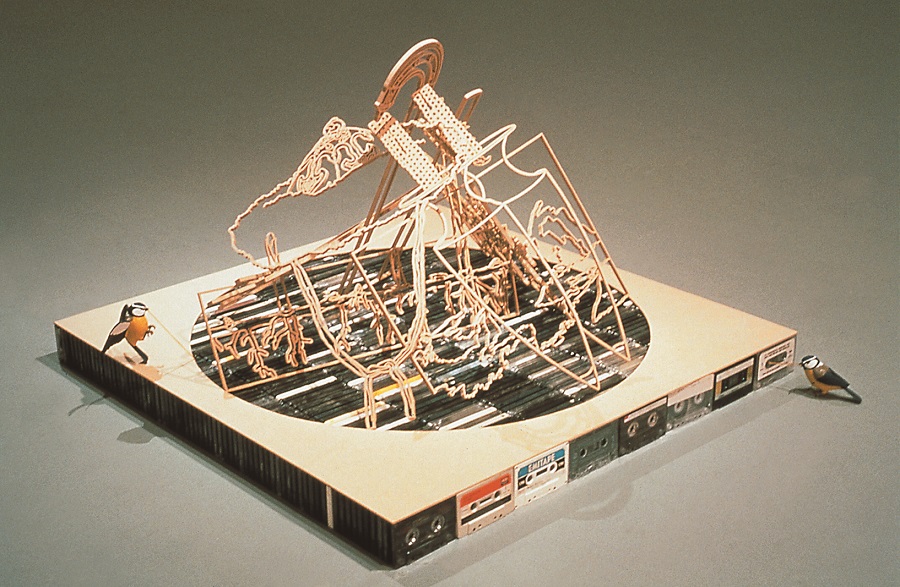The formal intricacy of the pieces' construction served to divert us into the deeply but idly wondering gaze of a reflection that was both adult and childlike.
Tim Sterling
Born 1973, Adelaide, South Australia
Tim Sterling's work–intricately, meticulously, obsessively constructed–covers quite a spectrum: signification that ranges from the hot overload of Bomb to the 'cool' of the large transparent grid shown at Roslyn Oxley and at the EAF this year in the solo show, Trajectory. All invite the dual application of the viewer's wonder and curiosity in tandem with an investigative, constructive imaginative engagement.
In Trajectory, Sterling disposed a group of his pieces–to make more evident than hitherto their other, less formalist and more fictive function. These played on two spatial and architectural themes. One concerned office space and workaday utilitarian furniture and fittings: wastepaper bin, air–conditioning vent, filing cabinet. The other posited the childhood space–and thereby the childhood 'time'–of playground and toys: a grid of bars to climb in and through. It would seem that they meant to overlay upon each other the one's supposed innocence (freedom, reverie and play) and the other's work–bound constraint and system. Which would make for a troubled, worrisome childhood–or a more mysteriously impish and feckless adult world. Or the suggestion of a continuum? The formal intricacy of the pieces' construction served to divert us into the deeply but idly wondering gaze of a reflection that was both adult and childlike.
The trompe l'oeil of the earlier Bomb might suggest Duane Michaels, Douglas Huebler or Sterling's own local contemporary Kristian Burford. The later work, in contrast, reminds of Sol LeWitt, Robert Morris, Larry Bell or Agnes Martin. But where these artists are associated with system, the cool and rational, Sterling's art works to dismantle or question the rational, to suggest (and allow in to our perceiving) our dissatisfaction with it.
Bomb presented a kind of rebus–complete with surrogate viewer: the puzzling birds, two of them, that play at unravelling the piece's unspooling cassette–tape ribbon, mimic an involvement that stands for ours and serves to induce it. The large cube (Not yet titled, 1) functions–as did Sol LeWitt's gridded sculptural permutations–to have our rational conception explain and inform our sensory inventory of the object and its identification or certification as grid, cube or whatever. (We see it when we believe it.) Sterling's pieces, though, through their fragility and transparency, require constant re–verification: gleams and reflections, temporary invisibilities or transparency, render them permanently unstable, evanescent. Around and through this impasse and engagement a wider cloud of thought and feeling bleeds in.
Ken Bolton from his Samstag catalogue essay, New Brew: Export Quality Six–Pack
2004 Anne & Gordon Samstag International Visual Arts Scholarship
2004 Graduate Program, Sandberg Institute, Amsterdam, The Netherlands
1999 Bachelor of Visual Arts - Honours 1st class, University of South Australia, Adelaide
1998 Bachelor of Visual Arts, University of South Australia, Adelaide
Artist's website
http://timsterling.com.au/

